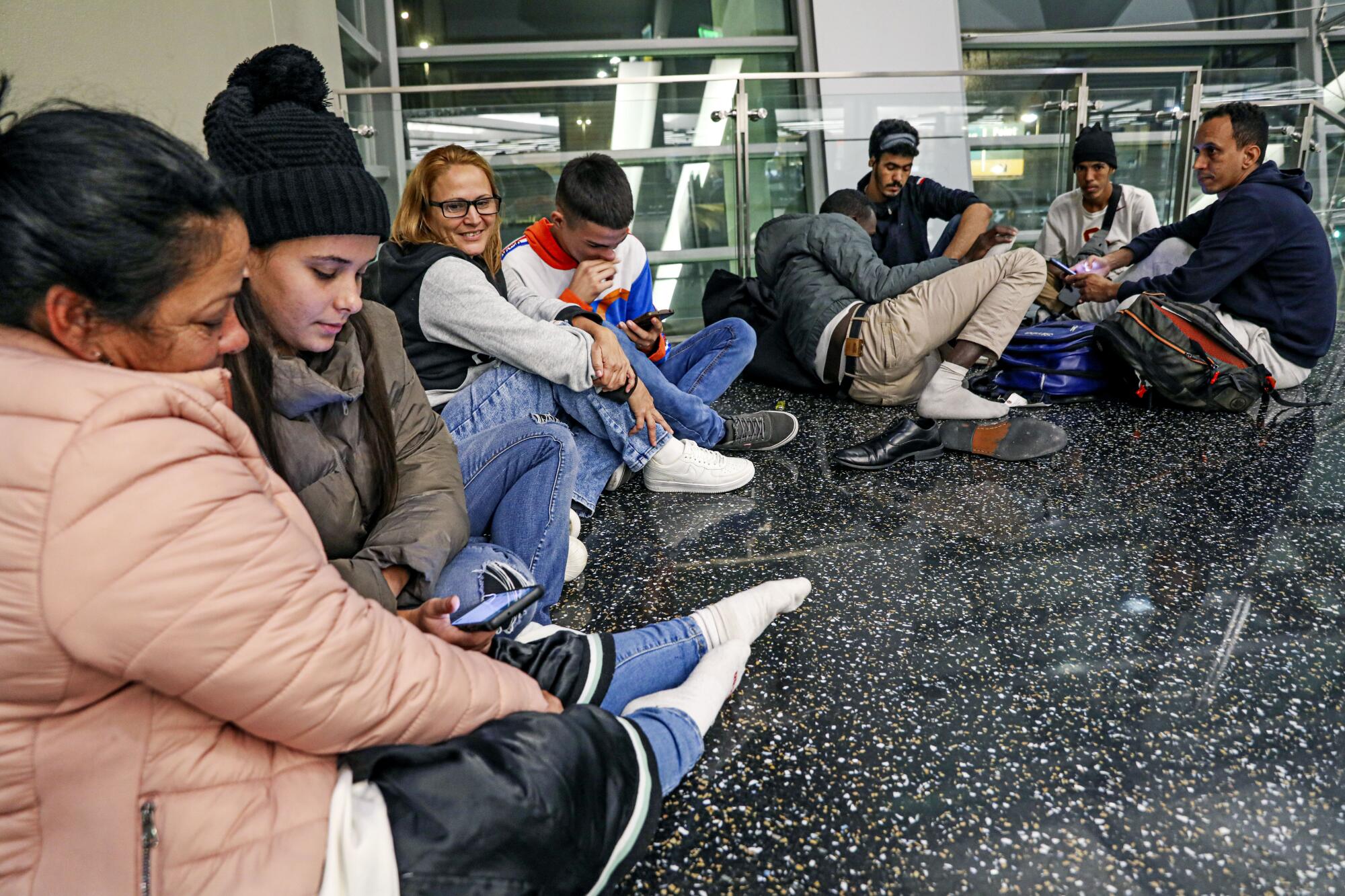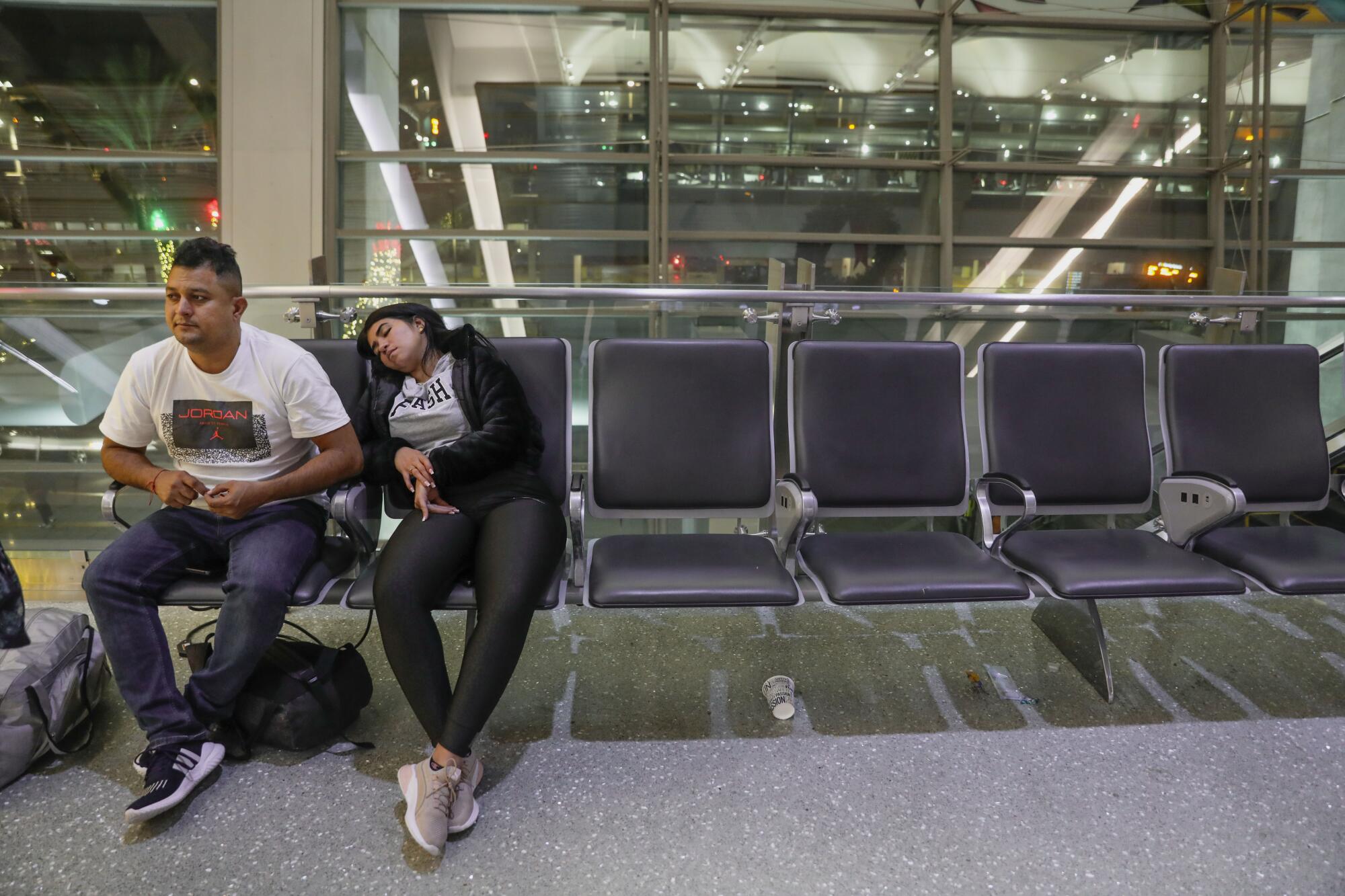Joel Velasco Salazar and his two friends stood in a corner of Terminal 2, holding their few belongings and preparing to tuck in for a long, uncomfortable night at the San Diego International Airport. Others rested on the chairs and floor around them.
They were among the more than 100 migrants each night who have slept at the airport over the past week after crossing the U.S.-Mexico border and being processed by Border Patrol. Now, they’re trying to continue on their journey to be received by friends and family in cities across the U.S.
This story is for subscribers
We offer subscribers exclusive access to our best journalism.
Thank you for your support.
The three Ecuadorian men didn’t have blankets or pillows. And a late dinner seemed out of the question as they stood by a bagel shop that had closed at 9 p.m. and a shuttered newsstand.
“We need food,” one of Salazar’s travel companions said.
Many migrants are arriving at the airport several hours — and sometimes a few days — before their scheduled flights. Some arrive without a purchased ticket at all, according to aid groups. With upcoming holiday travel expected to make the airport even busier, on top of the ongoing construction at Terminal One, the groups say they are looking for ways to streamline the travel process for migrants and ensure their safety — especially as their numbers have significantly increased in recent weeks.

The Piovet family, from Cuba, sits at the San Diego International Airport Friday night.
(Sandy Huffaker/For The San Diego Union-Tribune)
Many of the migrants are dropped off at the airport by SBCS, a nonprofit that is coordinating a multitude of services alongside other nonprofits at the region’s primary migrant welcome center in central San Diego. There, migrants get basic services such as food, water and Wi-Fi before continuing on.
Others may take their own transportation to the airport.
“Most people that are getting dropped off have somewhere to go and they know someone, so most people end up at the airport,” said Krystle Johnson, a volunteer with We All We Got, a mutual aid fund that has assisted migrants at the airport since September. “But sometimes there’s confusion, and people say they have a flight but what they mean is they’re waiting for money to get their flight, and the airport is just a really confusing place.”
About 100 to 200 migrants slept at the airport each night last week, according to the Immigrant Defenders Law Center, which has been trying to count the number of people each day, though some nights it gets an estimate. On Friday night, there were at least 100 migrants and 133 on Saturday, including 10 children. Though the organization didn’t get the count on Sunday, at least 145 meals were distributed in the evening.
One night last week, at least 220 migrants slept at the airport.
The number of migrant children and women showing up at the airport has been concerning for the aid groups. Children are considered one of the vulnerable populations that are usually sent to sheltering services such as those run by Jewish Family Service and Catholic Charities of San Diego.
In September, Johnson said that volunteers first saw 30 to 40 migrants sleeping at the airport each night. In the last few weeks, though, the number has risen, first to around 60 each night but then higher in the last few weeks.
“It’s grown exponentially, and we’re not totally sure why,” Johnson said. “It’s almost becoming a second (migrant welcome) center because there’s so many people there.”
We All We Got, along with the mutual aid group Detention Resistance, drops off food, water and hygiene kits for migrants in the morning and evening. Immigrant Defenders Law Center started working on site this month, as well, to offer migrants travel assistance such as printing out their tickets, navigating the airport and finding somewhere safe to sleep.
Immigrant Defenders Law Center says the airport has helped them secure a space to provide services to migrants near the check-in at Terminal One, as well as a place to store supplies such as water bottles.
Instead of staying in a centralized location of the airport, though, migrants are sleeping throughout both terminals, settled in chairs or along the walls.
Sheltering at the airport
SBCS, the nonprofit managing the welcome center in San Diego, runs several buses for migrants to the airport from the center each day.
Spokesperson Mindy Wright said that before SBCS heads to the airport, the staff requires migrants to show confirmation that they have a flight booked and scheduled for that day or the next.
The SBCS migrant center does not provide sheltering services on site, but the nonprofit says it does help coordinate overnight lodging for migrants who may need a place to stay at the end of the day, though the goal is for migrants to find and pay for their own place to sleep.
It also has partnerships with local churches, community groups and hotels where migrants can stay the night, Wright says.
Some migrants may also opt to find their own way to the airport, whether from the welcome center, Border Patrol processing stations or if they have been staying elsewhere in San Diego.
Mabel Benavedes traveled from Cuba with her son, nephew and cousin. They arrived in San Diego on Friday morning and said they took a taxi from San Ysidro directly to the airport after being processed.
The travelers had a flight booked for Saturday morning to Tampa, Fla., where most of their extended family lives.

The Benavedes family from Venezuela tries to get comfortable as they wait for flights on the floor.
(Sandy Huffaker/For The San Diego Union-Tribune)
Salazar and his friends, Franklin Guhming and Ernesto Alonso Yupanqui Naula, said Border Patrol dropped them off at the airport.
Border Patrol did not respond to questions about the migrant processing and transfers.
The three men said they left Ecuador for financial reasons; it was difficult to find work and provide for his family, Salazar said.
“In Ecuador, you can’t live,” Yupanqui Naula added.
The trio became friends on the journey from South America, though now Guhming and Yupanqui Naula are traveling to Texas, while Salazar is going to New York.
The three men asked passersby for help with their flight schedule logistics at one point and were assisted by two women travelers.
Overnight stays by migrants have been common at the airport for at least the past year.
“Since late last year, San Diego International Airport has experienced a significant increase in the number of migrants using the airport to proceed to their next destination,” the airport said in a statement. “We have and will continue to coordinate with migrant-serving volunteer groups and nonprofit organizations as they help their clients navigate the airport.”
The airport did not respond to the Union-Tribune’s questions about whether the current situation is impacting other travelers at the airport.
Streamlining the process
Immigrant Defenders Law Center is brainstorming ways to make the process more efficient for migrants, said managing attorney Paulina Reyes.
Travelers must wait four hours before going through TSA security to wait at their flight gates. Reyes said Immigrant Defenders Law Center is communicating with the airport about shortening that time frame so that migrants could get to their gate — and more available seating and food options located near the gates — faster.
“It’s not comfortable (for the migrants). The airport is not equipped to have people overnight in that manner,” Reyes said.
Reyes said that around 20 people arrive at the airport each day without a flight even booked. By the end of the day, about half of them find a flight, but Immigrant Defenders Law Center has identified a few unique cases, including some in which people have stayed three or four nights at the airport while they wait for their flight to be purchased by a family member.
For others, they have a flight booked, but it doesn’t leave for a few days.

Kenny Ramierez and his partner, both from Venezuela, rest in a row of chairs.
(Sandy Huffaker/The San Diego Union-Tribune)
More than 40,000 migrants have been processed by Border Patrol and released in San Diego County since mid-September, and nonprofit groups and aid organizations have struggled to keep up with the demand for resources.
The two nonprofits that typically shelter and assist traveling migrants have limited capacity and are taking only the most vulnerable populations, including the elderly, sick, women and young children and members of the LGBTQ community.
Jewish Family Service, which manages the San Diego Rapid Response Network shelter for asylum seekers, says it has space at its travel center for 77 people to sleep each night before their flights.
Catholic Charities of San Diego similarly helps migrants obtain flights and accompanies them to the airport, through security and to their gate.
Catholic Charities CEO Vino Pajanor said he’s worried about the high cost of travel for migrants heading into the holiday season. While many migrants know their final destination and can book a flight, he says, Catholic Charities helps secure funding for those who need assistance with the flight purchase.
“We’ve seen it in the last two and three years that we’ve done this. Ticket (prices) are going to increase like crazy,” he said.
Public transportation that many volunteers take to the airport to aid the waiting migrants — often while lugging 100 to 200 sandwiches with them — will also likely get busier as the holiday season picks up, said Johnson of We All We Got.
Staff from Immigrant Defenders Law Center are hoping to start accompanying migrants through security and to their flight gates, as Jewish Family Service and Catholic Charities are able to do, to help streamline the process for migrants.
“We’re trying to figure that out,” Reyes said. “Our biggest goal is to make sure people are safe and have food and basic needs.”

